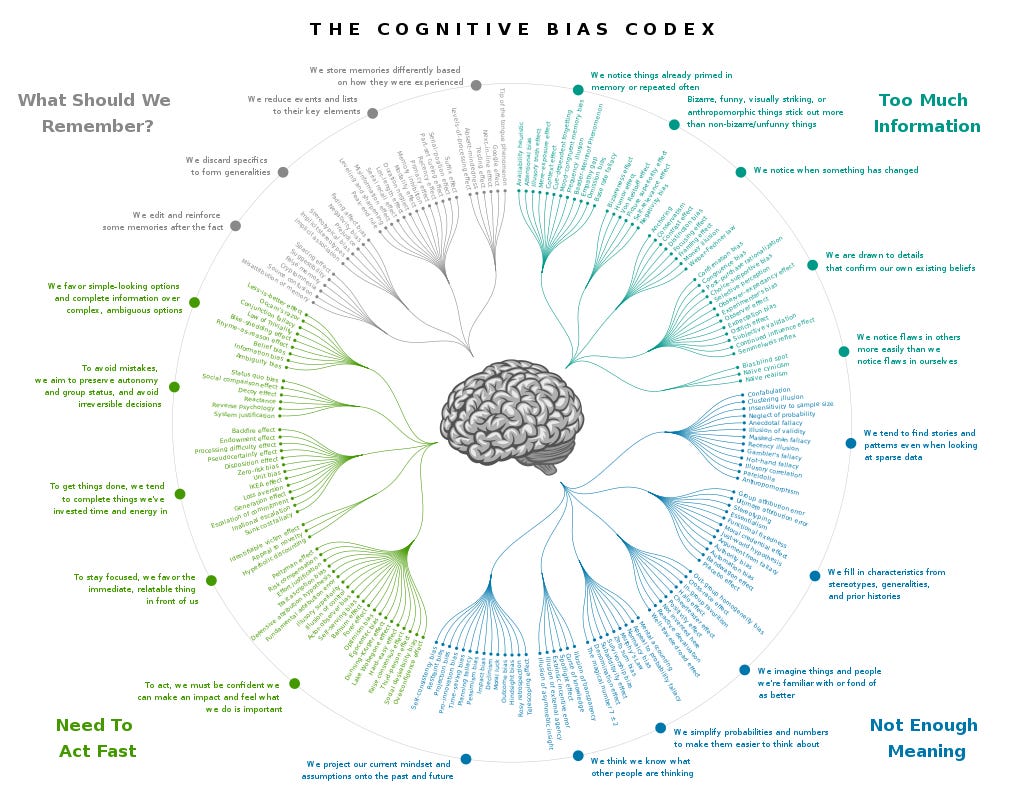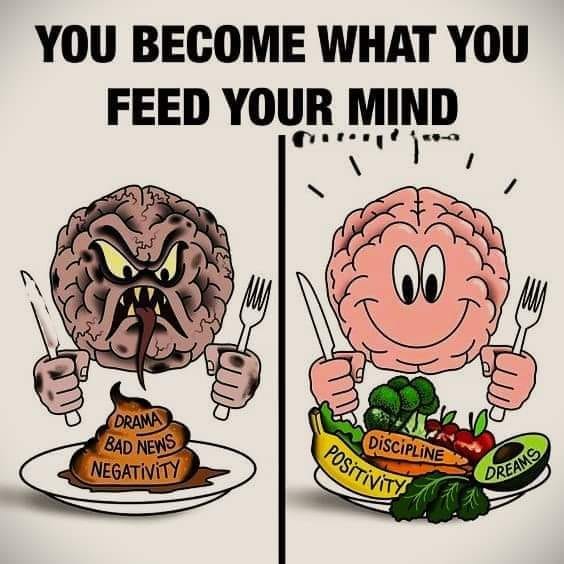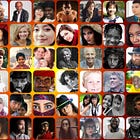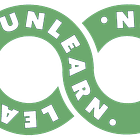Welcome to Polymathic Being, a place to explore counterintuitive insights across multiple domains. These essays explore common topics from different perspectives and disciplines to uncover unique insights and solutions.
Today's topic is another of our Mixed Mental Arts and introduces a fun term, Infobesity, referring to the information overload and mental saturation that we face every day. Join in as we uncover the consequences affecting how we process the world and how too much information can create political divides. We’ll end with recommendations to improve our information fitness.
Introduction
Let’s take a moment and think of information like we think of food. We know that a diet of ultra-processed, commercially produced, marginally nutritious, and sugar-laden food, in large quantities, leads to physical obesity and subsequent health issues.
Information follows the same pattern. News media commercially churns out a never-ending torrent of information. Social media influencers are ultra-processed and contrived while the algorithms feed us sugar-laden clickbait. Our information diet typically contains limited mental nutrition to keep our brains fit and healthy.
Then add in the opinions that most problems can be solved with more information. If only we had just a bit more we’d be able to overcome all social ills. Terms like ‘low information’ or ‘uninformed’ voters are used as a pejorative and the solution is always to pour more and more information down the throats of audiences. If we top it off by blocking access to opposing information there’s no balance to our diet.
Counterintuitively, this approach is also guaranteed to backfire. More information is not better because we are not cognitively wired to make better decisions based on more information. We are wired for exactly the opposite and all this information is just making us cognitively obese, out of shape mentally, with decision fatigue.
Our Efficient Brain
My research has found that the first line in our brain’s job description is to make sense of the world around us. The brain is powerful and complex and, while the anatomy of our brains varies little from person to person, no two people perceive the world exactly the same. Individual variation in perception is a function of cognitive, affective, and memory processes that filter and sort sensory information on its way to perception, and ultimately behavior.
Then we add in the layer of human culture that we inherit which represents a collective brain of humanity. Cultures can vary in priorities, beliefs, and traditions, and yet their fundamental purpose is to allow large groups of people to collaborate effectively. Like our brains, no two cultures perceive the world the same either.
Our individual and cultural brains identify patterns to make sense of this chaotic and dangerous world. They leverage personal and group experiences, distill them into heuristics, and apply them to sort through the noise to help us survive.
The second line in our brain’s job description is to be efficient. We can’t see all, hear all, or know all. Our poor little brains can’t even process it all if we could see, hear, or know all. This is where those individual and cultural sense-making heuristics come into play to reduce the cognitive burden and they manifest as cognitive biases.
Incredibly, we have over 200 cognitive biases structured around 4 categories. They allow you to deal with too much information, make decisions without enough meaning, act fast, and process information into useful memories.

You can’t not bias. There’s literally no way to avoid it if you wanted to and, as we explored in Stereotyping Properly, we apply profiles to ourselves so that we can intentionally trigger the biases of others for efficient interactions (think team uniforms and status signals.) They’re too valuable to not use.
Our brain is insanely efficient at processing messy, incomplete, and fractured information, making sense of it, and quickly formulating an action or reaction that strives to maximize survival. As you can imagine, pouring an insane amount of information into that system can quickly gum it up.
Infobesity
Those 200 cognitive biases work decently well when they are applied individually or in a linear sequence. However, the piles of vapid information that constantly flow past and demands that we process it all quickly force us to layer at least four biases on almost everything we encounter these days.
The danger is that biases that work well individually don’t have that same accuracy when they are stacked. I haven’t seen stacked biases lead to a central, common, ground and instead, I think they angle us toward the edges. Worse, new research shows political bias, coupled with cognitive bias, exacerbates the problem.
Twitter is a great example. There’s too much information as new Tweets are constantly flowing in. There’s not enough meaning as posts are mostly memes, headlines, or text constrained to 280 characters. There’s an unrealistic need to act fast to trend or even stay relevant. Lastly, everything is clickbait, fear porn, and outrage flattening the signal about what’s important to remember.
To process it all, we have to stack a bias from each of those four categories. The end state is that Twitter becomes heavily polarized because our brains become too fat and too saturated, as the sludge of information overwhelms our ability to make sense of it. Like physical weight gain, it becomes easier and easier to consume and harder and harder to get the brain exercising efficiently again.
Like the slippery slope of physical health, we don’t notice the slide of those stacked biases because our brains have another safety mechanism called Cognitive Dissonance. This is a function of our brain’s efficiency and sense-making and provides cognitive smoothing that hides gaps and inconsistencies.
It’s so efficient that, like the blind spots in our eyes, cognitive dissonance will remove the inconsistencies from our consciousness altogether. This isn’t an issue with a single bias or their application one at a time but when we stack biases, the lurch toward the edge is greater, and just as effectively smoothed and forgotten.
Jonathan Swift identifies the paradigm well in that:
“Reasoning will never make a man correct an ill opinion, which by reasoning he never acquired.”
Claire Lehmann, from Quillette, also captures this risk very well in Stop Calling People “Low Information Voters” where she suggests that:
“… ’high information’ people are not immune to irrationality. They are just as likely to be ideologues who are resistant to updating their beliefs when faced with new evidence. This includes social scientists.”
Stacked biases plus cognitive smoothing happen through our individual and cultural brains and are not reasoned. We are typically not even conscious it’s happening and these bias stacks are prone to lead to polarization and division.
Thankfully it’s not that hard to take action. We’ve identified how it happens and what the brain’s response to the over-saturation of information is. Just like a physical body that we’ve let slip, we can now take steps to address the diet and exercise of our brain and get ourselves back on track.
Information Diet
Let’s start first with Diet. We’ve discussed tips like How to Train Your Algorithm to make sure you are in control of what information you are being fed. If you don’t want to step away from social media, you can still take an active approach to managing it.
Another step, instead of being force-fed a diet of information others think is important, is to find services that help curate, refine, and filter content that you want to be targetted by. Curators Refind can be used as information dieticians that send tailored articles based on your intentional selections. Others, like 1440 offer news headlines with no clickbait so I can keep up without the bias.
Other writers, like
who writes , and where I got the idea for Infobesity, has a very polymathic approach to his work and recommends others who are avoiding hyperbole and clickbait. We can filter our information like we filter our food selection and bring healthy content back into our information diet.Mental Exercise
Next, let’s look at exercising our brains. The entire genesis of Polymathic Being is rooted in the concept of Mixed Mental Arts. The first step is to Embrace Your Whitebelt and get ready to grapple with complex ideas. Sometimes you’ll take a punch, and sometimes you’ll land one, but you should always have insatiable curiosity and the drive to learn, unlearn, and relearn.
There is a whole series of mental arts we’ve explored here and I’d like to highlight two that are crucial for exercising our brain. First, I recommend Systems Thinking where we dove deep into stepping back from the easy answer and looking for new perspectives.
Second, we introduced a framework for Critical Thinking that details a trifecta of intentional knowledge gathering, the application of logic to form, unform, and reform ideas, and the application of critique to test our assumptions. These provide a solid entry point to begin exercising our brains to better process information.
Summary
Infobesity is the function of consuming, without intentional control, a vast array of ultra-processed, commercially produced, and marginally nutritious information. Unchecked, our brains still digest it all using stacked biases which are cognitively smoothed over so we don’t see the immediate effect. The result is polarization, division, fear, loss of trust, and loneliness.
It sounds dire but it’s something we have agency to take control of. We have the power to put our brains on a healthier diet and we have the mixed mental arts to begin exercising it so we can get back in tip-top shape. And just like losing weight is good for physical health so too, overcoming infobesity is great for mental health.
I’d love to know your thoughts, experiences, and additional ideas on this topic. Please feel free to share here in a comment or join us on Notes, Substack’s social media arm, which is, thankfully, not at all like Twitter!
Enjoyed this post? Hit the ❤️ button above or below because it helps more people discover Substacks like this one and that’s a great thing. Also please share here or in your network to help us grow.
Polymathic Being is a reader-supported publication. Becoming a paid member keeps these essays open for everyone. Hurry and grab 20% off an annual subscription. That’s $24 a year or $2 a month. It’s just 50¢ an essay and makes a big difference.
Further Reading from Authors I Appreciate
I highly recommend the following Substacks for their great content and complementary explorations of topics that Polymathic Being shares.
- All-around great daily essays
- Insightful Life Tips and Tricks
- Highly useful insights into using AI for writing
- Integrating AI into education
- Computer Science for Everyone

















New terms and concepts that I learnt about from this post that I've certainly felt and experienced but didn't know of. I like the graphics that go with it. Can't help but think this is a dense piece so grateful for the recording, as it was more digestible for me. But the piece I keep returning to is the decision fatigue. Is that even a thing? I had no idea but have certainly felt it many a times. How does one go back to avoiding decision fatigue? I'll definitely link this post in my weekly SPAWN session and bring more attention to this post.
Great post. Looking forward to following up on all your links (I saved them to a Notion page).
Learning the fundamentals of information theory was a helpful filter for me. Treat information seeking as seeking to reduce uncertainty about a statement of fact (a proposition, in analytic philosophy terms), or about a decision you need to make. The first information you collect is highly impactful, but as you seek more and more information the impact on the truth/falsity judgment of the statement of fact or decision is less and lessmThat means there is a limit to the amount of information you need to collect, due to declining marginal utility.
As a simple example, consider figuring out whether to bring a coat when you go out in the afternoon. You check the sky, you feel the air outside, and you check a weather service. Then you're done: you know enough to decide, and your only further query might be about what specific cost to bring (windbreaker or raincoat).